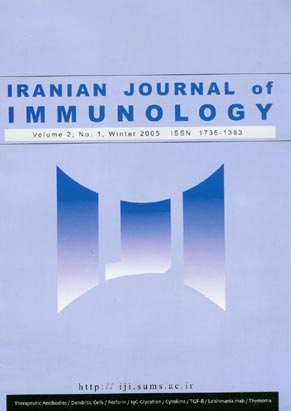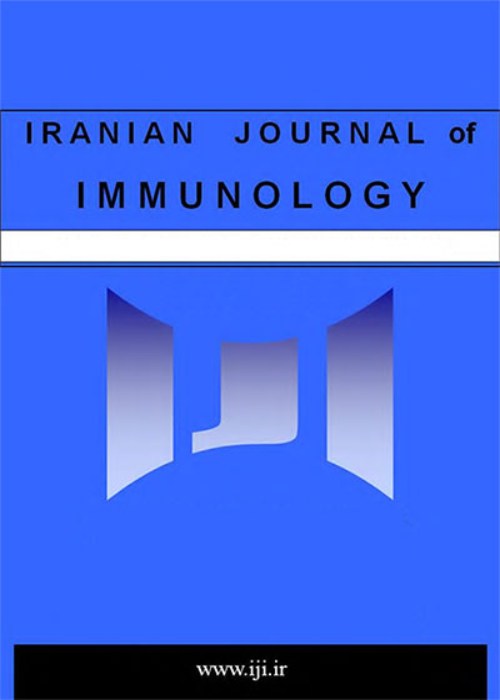فهرست مطالب

Iranian journal of immunology
Volume:2 Issue: 1, Winter 2005
- 66 صفحه،
- تاریخ انتشار: 1384/03/30
- تعداد عناوین: 9
-
-
Pages 3-20Despite the major advances in conventional forms of treatment (i.e. surgical techniques, radiotherapy and chemotherapy) and improved survival rates, cancer is still the second leading cause of death in developing countries. One major limitation of cytotoxic drugs and radiation in the treatment of cancer patients is their inability to discriminate between malignant and normal tissues. This in turn prevents the delivery of the optimal (therapeutic) dose of such agents to malignant tissues for their eradication. With the advent of hybridoma technology in 1975, it has been possible for the first time to produce large amounts of an antibody (i.e. monoclonal antibody) against any antigens of interest. Since each antibody is highly specific for a particular antigen, this typical feature of the antibodies has resulted in their widespread use in diagnostic kits, medical research (e.g. to unravel the function of the antigen in physiological and pathological conditions), and more recently, for the management of a wide range of human diseases such as autoimmune disease and human cancers. Thanks to recent advances in genetic engineering, the immunogenicity of rodent antibodies was reduced by producing the chimeric or humanized version of such antibodies or by developing the fully human antibodies. In other instances, as intact antibodies are too large for rapid penetration into solid tumours, it has been possible to develop a smaller fragment of such antibodies (e.g. Fab, scFv, VHH) with greater potential for use in cancer imaging and therapy. Depending on the target antigens and the antibody format, monoclonal antibodies can induce their anti-tumour activities by several mechanisms including activation of the host effector cells. To date, several mAbs have been approved for management of human cancers including: anti-EGFR antibody cetuximab and anti-VEGF antibody bevacizumab for treatment of metastatic colorectal cancer, anti-HER-2 antibody trastuzumab for metastatic breast cancer, anti-CD20 antibodies rituximab and ibritumomab tituxetan for non-Hodgkin lymphoma, anti- CD52 antibody alemeutumab for chronic lymphocytic leukaemia, and anti-CD33 antibody gemutuzumab ozogamicin for the treatment of acute myeloid leukaemia patients. Monoclonal antibodies currently account for about 30% of all new drugs in development, with more than 500 antibodies at different stages of clinical trials worldwide. In this review, the characteristic features of some of the therapeutic antibodies and the antigens recognised by such antibodies will be discussed as well as several challenges that need to be addressed in order to facilitate their widespread use as “magic bullets” in the management of human diseases and in particular human cancers.
-
Pages 21-28BackgroundDendritic cells (DCs) are the most potent stimulators of primary T cell responses and play a key role in immune reactions after stem cell transplantation. Very little is known about the cord blood (CB) dendritic cells and their potential involvement in the low incidence and lower severity of acute graft-versus-host disease after CB transplantation.ObjectivesThe aim of this study was the isolation of cord blood and peripheral blood dendritic cells and comparison of their functional competence and determination of their probable role in graft versus host disease after stem cell transplantation.MethodsIn this study, fresh peripheral blood DCs (PBDCs) were enriched as HLA-DR+ cells, lacking the CD3, CD11b, CD14, CD16, CD19 and CD56, using immunomagnetic bead depletion. For cord blood dendritic cells (CBDCs) enrichment CD34+ and CD66b+ cells were needed to be depleted too. Immunomagnetically enriched PB/CB dendritic cells were co-cultured with adult T lymphocytes and cell proliferation was measured by 3H-thymidine incorporation.ResultsResults showed that CBDCs were significantly poor stimulators of the mixed leukocyte reaction as compared with PBDCs (P< 0.05).ConclusionThe demonstrated impairment of CBDCs function could be of importance in interpretation of the low incidence and milder severity of graft-versus-host disease (GVHD) in umbilical CB transplantation compared with peripheral blood or bone marrow stem cell transplantation.
-
Pages 29-35BackgroundPerforin is known to be important in cytolytic activity mediated by natural killer (NK) cells.ObjectiveTo study the relationship between the efficiency of NK and lymphokine-activated killer (LAK) cells activity, and the expression of perforin and HLA class I molecules.MethodsLAK cells were generated by in vitro culturing of human peripheral blood lymphocytes (PBLs) in the presence of human recombinant interleukin-2 (rIL-2). Cytotoxic activity was measured at different intervals of activation by MTT colorimetric assay using different human tumor cell lines. Immunocytochemical staining of molecules was performed on LAK/NK cells using specific monoclonal antibodies and Biotin-conjugated anti-immunoglobulin.ResultsLAK/NK killing against Fen and two other cell lines, KB and Scaber showed that at day 9 and 15 of activation, 57% to 60% and 45.5% to 92.5% of Fen cells were killed at different E/T ratios. At the same time, the maximum percent killing against Scaber and KB cell lines was 47.3 and 54.3 at 5/1 ratio, respectively, showing that Fen cells were more sensitive than the two other cells. Time-course experiments using Fen cell line demonstrated 60.0, 83.9 and 34.8 percent killing at days 9, 15 and 22 at 10/1 E/T ratios. When other E/T ratios were investigated, a similar profile was observed.The maximum activity was at day 15 and 5/1 E/T ratio (92.5%). In immunocytochemicalstaining of activated LAK cells, 75.9% to 86.3% of LAK cells expressed HLA class I molecules. Perforin expression changed from 30.3% at day 7 to 42.7% at day 17 followed by a decrease to 27.9% at day 24.ConclusionThese data indicate that perforin expression is closely correlated with NK/LAK killing activity.
-
Pages 36-42BackgroundGlycation of proteins is a non-enzymatic spontaneous process that occurs in diabetes mellitus and aging, altering the structure and function of proteins. IgG undergoes glycation leading to changes in its reactivity to antigen and fixation of complement.ObjectiveThis study aimed at revealing the effect of glycation on the interaction of IgG with anti-IgG using electroimmunoassay.MethodsPurified human IgG was glycated with different concentrations of glucose and different periods of treatment. Glycation was measured using thiobarbituric acid reaction. Glycated and non-glycated IgG were subjected to electroimmunoassay, and the height of the precipitated rings were measured and compared.ResultsThe results showed that IgG was glycated in vitro and the level of glycation was dependent on the glucose concentration and duration of treatment with glucose. The height of glycated IgG peaks formed in the electroimmunoassay was significantly lower than those of nonglycated IgG (p < 0.01).ConclusionThe results indicated that in vitro glycation of IgG leads to structural changes altering its mobility in the electroimmunoassay. Moreover, it suggests that this alteration may cause the weakness of its interaction with anti-IgG. This phenomenon may play a role in the susceptibility of diabetic patients to infection.
-
Pages 43-49Background-thalassemia as a hereditary disease is defined as defective synthesis of -globin chains, resulting in erythropoiesis abnormalities and severe anemia. Different studies have shown that cytokines and cytokine gene polymorphisms play a major role in the pathogenesis of -thalassemia. Single nucleotide polymorphisms (SNPs) within the promoter region or other regulatory sequences of cytokine genes lead to overall production of cytokines.ObjectiveTo analyze the genetic profile of Th1 and Th2 cytokines in Iranian patients with -thalassemia major.MethodsAllelic and genotype frequencies of cytokine genes were determined in 30 thalassemia patients and 40 healthy subjects using PCR-SSP assay. Allele and genotype frequencies were calculated and compared with those of normal controls.ResultsThe results of our study show a significant decrease in A allele at position UTR 5644 IFN-, G alleles at position -238 TNF- and 166 IL-2, and C allele at position -590 IL-4. TGFhaplotype TG/TG increased whereas TGF- haplotype CG/CG and IL-10 haplotype GCC/ACC decreased significantly in all patients.ConclusionData of this investigation suggest that variations among cytokine gene polymorphisms may contribute to the disease susceptibility. A finding which needs to be fairly clarified in other ethnic groups.
-
Pages 50-55BackgroundSuccessful pregnancy in allopregnant women depends upon the control of graft rejection mechanisms. It has been suggested that some immunosuppressive cytokines contribute to successful pregnancy and transplantation. Transforming growth factor beta (TGF-) exhibits potent immunoregulatory and anti-inflammatory properties which might prolong graft survival. Recent studies suggest a role for TGFin the generation of T-regulatory lymphocytes which preserves the tolerance to peripheral self antigens and may control the response to allogenic tissues and thereby promote the transplantation tolerance. Also, the function of TGF- in trophoblast differentiation and hypertension is reported.ObjectiveTo evaluate the maternal serum TGF- 1 level in normal allopregnant women and in pregnancies complicated by preeclampcia (PE).MethodsSixty one pregnant preeclamptic women (32 cases with severe and 29 with mild PE), 22 normotensive healthy pregnant, and 20 non-pregnant controls constituted the studied groups. The active form of TGF- 1 in serum from all cases was investigated by indirect ELISAtechnique.ResultsThe results showed that TGF- 1 level was higher in all three pregnant groups as compared with the nonpregnant controls. No significant changes in serum levels of TGF- 1 were found in PE as compared with the normal pregnancy.ConclusionTGF- 1 may function as a regulatory factor in fetal allograft survival during pregnancy, and TGF- 1 does not have a pathophysiological role in PE.
-
Pages 56-62BackgroundDifferent methods have been used for characterization of Leishmania promastigotes. Monoclonal antibodies are useful in characterization of Leishmania spp. both amastogotes and promastigotes.ObjectiveComparing the characterization of Leishmania spp. promastigotes with immunoperoxidase test (Avidin-Biotin) techniques and an indirect immunofluorescent assay (IFA).MethodsApplication of specific monoclonal antibodies for characterization of different Leishmania species. Immunoperoxidase tests (Avidin-Biotin) and indirect immunofluorescent assay (IFA) were employed for characterization of different Leishmnia promastigotes from culture. Five monoclonal antibodies including LXXVIII-2E5- A8 (D2) specific for L. donovani:L. infantum, IS2-2B4 (A11) specific for L. tropica, XCIV-H2- AB (T10) specific for L. tropica, XLVI-5B8- B3 (T1) specific for L. major, and T7 reactive toboth L. major and L. tropica as well as an anti GP63 mAb were used.ResultsThe best result was obtained with the dilution of 1:50 for both mAb and conjugate. One hundred percent sensitivity and specificity was achieved for characterization of Leishmania promastogotes with both methods.ConclusionAs immunoperoxidase method needs less equipments compared to IFA technique, it would be a preferred method for characterization of promastigotes.
-
Pages 63-65A 40 year old female presented with a history of cough for 1.5 years and diarrhea for 5 days. She further had a history of pinkish discoloration of skin and red-crusted papules on the anterior and posterior parts of the trunk. Chest X-ray and chest CTScan revealed focal nodular densities in lung besides an anterior mediastinal mass. The mediastinal mass was surgically removed and the pathologic diagnosis was a lymphocytic type of thymoma (Fig. 1). Laboratory data showed low albumin (2.9 gr/dl), high alkaline phosphatase (1448 units/l), high SGOT and SGPT (107 units/l and 128 units/l, respectively) with total billirubin of 1.38 (mg/dl), direct billirubin of 0.52 (mg/dl) and Gt: 440 (Normal < 40). Other positive findings included ANA: 1/640 speckled pattern, low hemoglobin: 9.1 (g/dl), mild eosinophilia (595/mm3) and positive occult blood in stool, with normal WBC, BUN, Na, K, Ca, PO4 and uric acid. Serum immunoelectrophoresis, abdominal sonography, fine needle aspiration of liver and endoscopic retrograde cholongiography were all normal. The report of skin biopsy indicated a lichen planus bolus type lesion. Colonoscopy detected points of inflammation with thick mucosa and biopsy was in favor of ulcerative colitis. Due to severe photophobia, she had previously consulted with an ophthalmologist revealing keratoconjuctivits sicca due to dry eye. Four months later, she was expired due to severe pneumonia and sepsis.
-
Adult Thymus: A Forgotten Jail for Autoreactive T CellsPage 66


